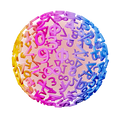What Is Decimal Notation?
A decimal number is a number that is symbolized by digits on either sides of a decimal separator (simply called a “point”). The digits after the point are also often called decimals. The first digit after the point represents the number of tenths.
Video Crash Courses
Want to watch animated videos and solve interactive exercises about decimal numbers? Click here to try the Video Crash Course called “Decimals”!
Example 1
Decimals with one digit after the point contains tenths:
If you have two digits after the point, your decimal contains both tenths and hundredths.
Example 2
Decimals with two digits after the point contains both tenths and hundredths:
Why do we actually need decimal notation? The number line contains tightly packed numbers. Despite their denseness, you will always find another number in-between two that seem like neighbors. Sounds cryptic... If we apply our decimal notation system, it becomes easy to see why this is true! The decimals are therefore the perfect tool to express yourself to whatever precision you find necessary.
Have a look:
Example 3
Which numbers, with only one digit after the point, lies between and ?
If you look at the number line shown above, is the only number with one digit after the point that lies between and .
Example 4
Which numbers, with only two digits after the point, lies between and ?
A number line will show that and are the numbers (with two digits after the point) which lie between and .
Example 5
Which number, with only three digits after the point, lies between and ?
A number line will show that and are the numbers (with three digits after the point) which lie between and .
Example 6
Write the numbers from smallest to largest.
Think About This
It is important to know that . But why is this so?
When you write , your number contains one tenth. When you write , your number contains ten hundredths. These numbers have the exact same value because . is just a more precise description of the same number.






















